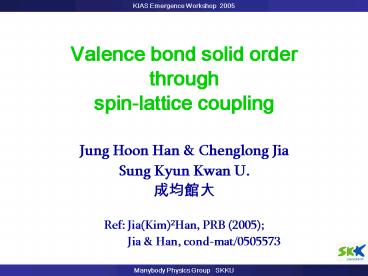Valence bond solid order through spin-lattice coupling - PowerPoint PPT Presentation
1 / 27
Title:
Valence bond solid order through spin-lattice coupling
Description:
of spins, rather individual, fluctuating spins (very unusual paramagnetic state! ... At finite temperature, thermal fluctuations smear out the inter-hexagon ... – PowerPoint PPT presentation
Number of Views:37
Avg rating:3.0/5.0
Title: Valence bond solid order through spin-lattice coupling
1
Valence bond solid orderthroughspin-lattice
coupling
Jung Hoon Han Chenglong Jia Sung Kyun Kwan
U. ???? Ref Jia(Kim)2Han, PRB (2005)
Jia Han, cond-mat/0505573
2
Lattice-Coupled Antiferromagnetic Spin Model
- Spin and lattice are coupled
- through magneto-striction
- effect (Pytte, PRB 1974)
Lattice displacement related to local spin-spin
correlation by
3
Application to Frustrated Lattices Triangular,
Kagome
NO LATTICE DEFORMATION!
4
Triangular/Kagome lattices meanfield theory
Ground state of Heisenberg model
gives 120 degrees for neighboring spins for
triangular/Kagome
According to linearized spin-lattice theory
local displacement is zero. Classical
degeneracy of Kagome is not lifted.
5
3D Frustrated Lattice - Pyrochlore
Tetrahedron as a building block Ground state
condition for each tetrahedron
Macroscopic classical ground state degeneracy in
pristine Heisenberg model
6
Lifting of degeneracy through spin-lattice
coupling
For pyrochlore lattice, there are infinitely many
ways to deform the lattice through linearized
spin-lattice coupling Some clues to the
deformation pattern must come from experiment
7
Experiments on Pyrochlore ZnCr2O4
Below Tc S.H.Lee et al. PRL, 2000
Spins on Cr3(S3/2) order antiferromagnetically
at as first-order transition,
acccompanied by cubic-to-tetragonal
distortion.
8
Theory of spin-Peierls transition by
Tschernyshyov, Moessner, and Sondhi TMS, PRL,
2002 TMS, PRB, 2002
Elongation (contraction) of a tetrahedron along
an axis And collinear antiferromagnetic spins is
the ground state
9
Experiments on Pyrochlore ZnCr2O4
Above Tc S.H.Lee et al. Nature, 2002
Neutron scattering of paramagnetic state at
T15K Structure factor consistent with
hexagon spin cluster (spin-loop director)
Conclude Neutrons scatter off a hexagon cluster
of spins, rather individual,
fluctuating spins (very unusual
paramagnetic state!)
10
Lifting of degeneracy through spin-lattice
coupling
Tetrahedron Unit (Tschernyshyov et al. PRL 2002)
Hexagon Unit (Jia et al. PRB 2005)
11
Interpreting Experiments as Spin-Lattice Coupling
Invoking spin-lattice coupling, each independent
hexagon shrinks, taking advantage of finite
lattice stiffness and lowering exchange energy
Directors of nearby hexagons interact via
12
Spins within a hexagon are collinearSpins of
nearby hexagons are orthogonal
Director-Director Interaction
13
Hexagon Organization of Spins in Pyrochlore
Hexagons form a super-lattice with each color
representing a director orientation All nearby
directors are orthogonal (3-states Potts)
14
Energy Comparison
In comparing energies for both distortion modes,
Tetrahedron-based distortion has a lower energy,
but hexagon shrinkage is a viable, metastable
state
15
A picture of paramagnetic state in ZnCr2O4
Spin-lattice interaction leads to enhanced
singlet (collinear antiferromagnet) tendency
within a hexagon Residual spin-lattice
interaction leads to orthogonality of nearby
directors (3-states Potts model) At finite
temperature, thermal fluctuations smear out the
inter-hexagon interaction, spin-spin correlation
remains confined to a single hexagon Further
lowering temperature might lead to condensation
of spin-loop directors, but it appears that a
tetragonal distortion pre-empts this possibility
in ZnCr2O4
16
Spin-Lattice Coupling in YMnO3
Katsufuji et al. PRB (2001)
Mn3 (S2) spins form triangular network in MnO2
plane
17
Experiments on triangular S2 AFM YMnO3
S Lee et al. PRB (2005)
Expansion of Mn triangles (red) at the onset of
magnetic order But simple spin-lattice theory
wont work.
18
New order parameter ?
- Possible order parameters of spin
- spin density wave magnetism
- valence-bond VBS or VBL(RVB)
19
Examples of VBS (AKLT states)
1D Chain (S1)
2D square (S2)
2D hexagonal (S3/2)
20
IDEA Spin-Lattice Coupling-induced VBS ?
Magnetic order doesnt work, but valence-bond
order might.
PARTIAL VBS ORDER
At most 4 VBs can form for coordination 6
Without SLC, VBs will resonante, but with SLC,
VBS patterns can be formed.
21
Calculations
Take spin-lattice Hamiltonian and use Schwinger
boson mean-field theory (Jia Han,
cond-mat/0505573)
Bose condensation
Bond order
LRO
Spin singlet
22
Results
Energy corresponding to a particular VBS pattern
below is lower than that of uniform state for
sufficiently large spin-lattice coupling strength
(Not spin
Jahn-Teller type)
23
Results
This state is also Bose-condensed, so LRO
co-exists with VBS
- Elementary excitations
- Spin waves for LROgt
- Triplet wave for PVBSgt
24
A New Excitation
We calculate excitation spectra for the VBS
within SMA
VBS
Spin wave
Comparison
25
Interpretation
(1) A new spectrum is gapped, has a minimum at
(4pi/3a,0), same as spin wave minimum (2)
Dispersion is extremely flat! Reminiscent of the
flat band in kagome AFM.
26
Relation to Experiments? YMnO3
- Tc70K
- Quasi-elastic peak at high T, into Neel region
- (Takagi fluctuating XY spins but 40K seems too
far from Tc) - Any sign of flat band? (must extract spin waves
first)
Park et al. PRB (2003)
27
Summary
- A naïve inclusion of magneto-striction leads to a
variety of interesting phenomena - Classical spin degeneracy of pyrochlore lattice
can be lifted through magneto-striction in a
number of interesting ways tetrahedron-based or
hexagon-based - Formation of valence-bond-solid is facilitated
by the spin-lattice coupling and may lead to an
interesting excitation spectrum































